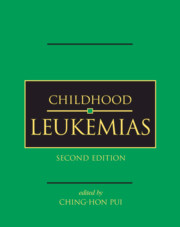Book contents
- Frontmatter
- Contents
- List of contributors
- Preface
- Part I History and general issues
- Part II Cell biology and pathobiology
- Part III Evaluation and treatment
- 14 Pharmacokinetic, pharmacodynamic, and pharmacogenetic considerations
- 15 Assays and molecular determinants of cellular drug resistance
- 16 Acute lymphoblastic leukemia
- 17 Relapsed acute lymphoblastic leukemia
- 18 B-cell acute lymphoblastic leukemia and Burkitt lymphoma
- 19 Acute myeloid leukemia
- 20 Relapsed acute myeloid leukemia
- 21 Myelodysplastic syndrome
- 22 Chronic myeloproliferative disorders
- 23 Hematopoietic stem cell transplantation
- 24 Acute leukemia in countries with limited resources
- 25 Antibody-targeted therapy
- 26 Adoptive cellular immunotherapy
- 27 Gene transfer: methods and applications
- 28 Minimal residual disease
- Part IV Complications and supportive care
- Index
- Plate Section between pages 400 and 401
- References
22 - Chronic myeloproliferative disorders
from Part III - Evaluation and treatment
Published online by Cambridge University Press: 01 July 2010
- Frontmatter
- Contents
- List of contributors
- Preface
- Part I History and general issues
- Part II Cell biology and pathobiology
- Part III Evaluation and treatment
- 14 Pharmacokinetic, pharmacodynamic, and pharmacogenetic considerations
- 15 Assays and molecular determinants of cellular drug resistance
- 16 Acute lymphoblastic leukemia
- 17 Relapsed acute lymphoblastic leukemia
- 18 B-cell acute lymphoblastic leukemia and Burkitt lymphoma
- 19 Acute myeloid leukemia
- 20 Relapsed acute myeloid leukemia
- 21 Myelodysplastic syndrome
- 22 Chronic myeloproliferative disorders
- 23 Hematopoietic stem cell transplantation
- 24 Acute leukemia in countries with limited resources
- 25 Antibody-targeted therapy
- 26 Adoptive cellular immunotherapy
- 27 Gene transfer: methods and applications
- 28 Minimal residual disease
- Part IV Complications and supportive care
- Index
- Plate Section between pages 400 and 401
- References
Summary
Introduction
In 1951, Dameshek first speculated on the observation that different chronic proliferative disorders share similar clinical and hematologic features and that patients with one of these diseases often develop, during the course of their illness, symptoms more typical of another disease, usually more severe than the original one. He coined the term “myeloproliferative disorders” (MPD) for these, now widely recognized, clonal proliferations of an abnormal hematopoietic stem cell. This group of related diseases, characterized by a variable propensity to evolve into acute leukemia, included chronic myeloid leukemia (CML), polycythemia vera, essential thrombocythemia and myelofibrosis with myeloid metaplasia (currently referred to as chronic idiopathic myelofibrosis). More than 50 years later, this classification, which is applicable to both adults and children, still maintains its clinical and biologic value. Apart from these acquired hematopoietic neoplasms, rare congenital genetic abnormalities can give rise to myeloproliferative disorders (Table 22.1).
Myeloid neoplasms that present with aberrant proliferative and dysplastic features have raised considerable controversy with respect to their classification. The recent classification system of the World Health Organization (WHO) groups these diseases with their variable effective or dysplastic hematopoiesis into a separate category of myelodysplastic/myeloproliferative disorders, including juvenile myelomonocytic leukemia (JMML), chronic myelomonocytic leukemia (CMML), atypical CML and a group of otherwise unclassifiable diseases. While JMML represents about 2% to 3% of leukemias in children, CMML and atypical CML are extremely rare in young people. CMML is occasionally diagnosed in an adolescent with persistent monocytosis, low blast count, and the absence of genetic features indicating JMML or CML.
- Type
- Chapter
- Information
- Childhood Leukemias , pp. 571 - 598Publisher: Cambridge University PressPrint publication year: 2006
References
- 10
- Cited by



